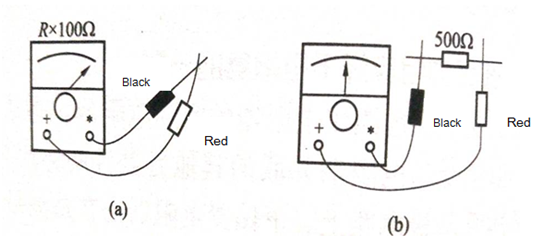How to detect the fixed resistors by multimeter?
An open-circuit method for detecting fixed resistors with a pointer multimeter.
The so-called open-circuit detection is the measurement of independent resistance, which is more accurate.
1. preparation before measurement.
Before measuring the fixed resistor, you should set the pointer-type multimeter zero, that is, connect the red and black pens, adjust the "zero" knob on the universal surface so that the pointer turns right to the "0Q" position, as shown in figure 1 (a).
2, the selection method of the baffle of the pointer multimeter.
There are several electrical barriers to the multimeter. When measuring, the multimeter should be placed in the appropriate range of the resistance (R) block. The basic principle should be to make the pointer indicator value fall as far as possible to the middle position of the scale, that is, the pointer indicator value falls as far as possible within the range of 20% ~ 80% radians at the beginning of the full scale, in order to make the detection more accurate. For example, the resistance below 50 can be measured by Rx1; the resistance from 50 to 1 thousand can be measured by Rx10 (or Rx100); the resistance from 1 to 200 kilo can be measured by Rx1k; and the resistance greater than 200 kilos can be measured by Rx 10k.

Figure 1
3. Measurement of resistance of unknown value.
The multimeter is placed in a gear, and the two pens are connected with the two pins of the measured resistance. At this time, the value indicated by the meter needle is the product of the number of measurements, that is, the resistance value of the resistance to be measured. For example, if the multimeter is placed in the Rx100 block with a stylus value of 5 [see figure 1 (b)], the resistance of the measured resistance is 5*100=500 Ω
In the measurement, if the pointer does not swing, it may be that the block is too small, the multimeter should be placed in the Rx1k block, and rescheduled to zero before measuring; If the pointer swing is still too small, you can also increase the retaining position until the pointer indicates a range of 20%-80% radians at the beginning of the head scale, because the resistance values obtained by reading the values within this range are more accurate, read out the resistance values, and the detection ends.
4. Analysis of measurement results.
The measured resistance values are allowed to have errors of + 5%, 10% or + 20%, respectively, between the actual readings and nominal resistance values, depending on the resistance error level.
In measurement, if it is found that the pointer is still not swinging at the highest retaining position, the fixed resistance is open inside the circuit and is no longer usable; on the contrary, when the pointer is still zero at the lowest retaining position, it indicates that the fixed resistance is short-circuit inside and cannot be used again.
5. The problems that should be paid attention to in the measurement.
(1). When measuring the fixed resistance, especially when measuring the resistance value more than ten thousand euros, the two fingers with the stylus cannot touch the two pins of the fixed resistor at the same time, otherwise, the measurement result will be affected by the parallel connection between the human resistance and the measured resistance. The resistor to be detected should be welded down from the circuit, at least one pin of the resistance should be welded off, so that the other components in the circuit will not affect the detection and cause the detection error.
(2). Although the resistance of the color ring resistor can be determined by the color ring mark, it is best to use the multimeter to detect its actual resistance value once before use to ensure proper use.

